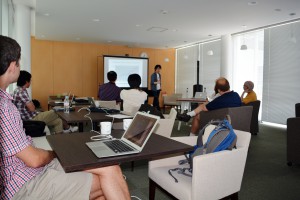ELSI Blog
16 Forming Planets in Kobe
While life at ELSI mostly plays out on the Tokyo Tech campus in Ookayama, a bit South of central Tokyo, from time to time we organize activities elsewhere in Japan. Our most recent occasion brought us to the glamorous city of Kobe, known for its great restaurants, its cheerful emphasis on illuminating anything in sight near its harbor, and for its lingering European influences dating from the late nineteenth century, soon after Japan opened up to the outside world. At that time Yokohama was the main port city to host a foreign influx in Kanto, the area near Tokyo, and Kobe played a similar role in Kansai, the area around Kyoto and Osaka.
This summer, various ELSI members having been forming planets in Kobe; or at least we have been talking about doing so: we have been working on writing computer codes to simulate planet formation, and we have discussed the physics that goes into those simulations as well as algorithms to encode that physics.
Here is the context: during a period of five weeks, July 22 through August 23, Jun Makino and I have been organizing a very informal "working workshop" on the topic of Large-Scale Simulations of the Formation and Evolution of Planetary Systems. The location of Kobe was chosen because of the presence of the K computer, two years ago the world's fastest supercomputer, built and run by the Japanese RIKEN organization. Our workshop was co-sponsored by RIKEN and ELSI.
Our "working workshop" idea was aimed at creating an atmosphere like the workshops in Aspen, or in the Kavli Institute for Theoretical Physics in Santa Barbara, places where people gather primarily to collaborate with each other, with only an occasional seminar, once a day or so. That has worked very well, thanks to the congenial atmosphere of Kobe University's Center for Planetary Science, which hosted our meetings in their building, conveniently right next to the K Computer Center, and straight in front of the train station "K Computer Mae", which means literally "station in front of the K computer". It may well be the only supercomputer center that has a train station named after it (the name of the station was changed from its previous name two years ago, to celebrate the fact that the K computer then beat the world computing speed record).

In the middle of our five weeks, we took a break from working, in order to hold a more traditional workshop, of the type where people actually talk more than work. Our "talking workshop" was held on July 7 and 8. The highlights of our talkshop were the two invited talks, by two visitors from the Southwest Research Institute in Boulder, CO, USA: by Bill Bottke on "Exploring the Early Bombardment of the Solar System" and by Hal Levison, on "Tackling Some Issues in Planet Formation -- From Mars's Size to a Fast Formation of Neptune".
Shorter talks were given by Koji Wada and Hiroshi Kobayashi about collisions between dust particles with sizes of microns, and by Junko Kominami about binary formation between Kuiper Belt objects with sizes of hundreds of kilometers. This already gives an idea of the huge range of length scales involved in the various stages of planet formation!
Three other talks were software and hardware oriented. Ryuji Morishima talked about algorithmic developments, Hanno Rein about the many advantages of an open source approach to code sharing, and Jun Makino gave us a glimpse of the next generation supercomputer, currently planned for construction in Japan, aiming at a speed of one Exaflops. Finally, during the afternoon of the second day we held an open discussion about the challenges ahead, for the next five years until the planned construction of the Japanese exascale computer. The photographs shown here were taken during that discussion.
For more information on this Kobe workshop, please go to: http://www.jmlab.jp/?page_id=216&lang=en











